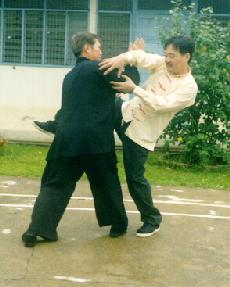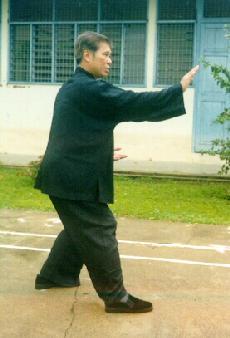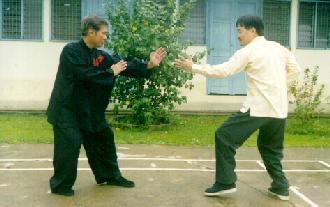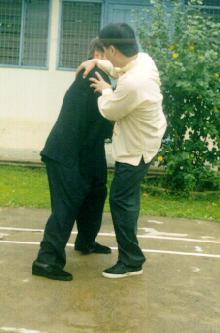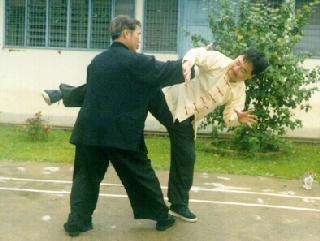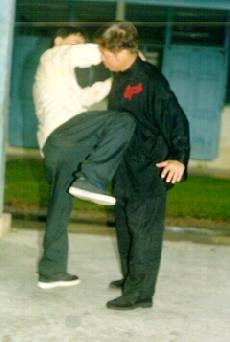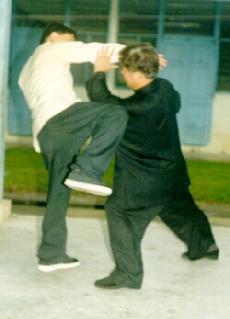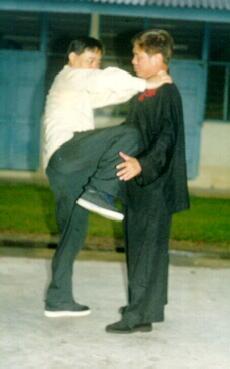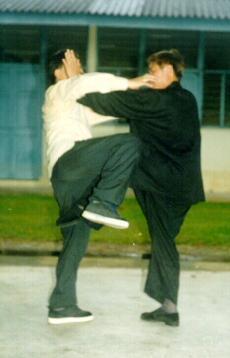SinShe Lo Ban Teng died at the age of 72 years in Jakarta (Indonesia) on 27.07.1958. His body became incinerated on 01.08.1958 in Muara Karang (Java). He wasn't only a respected healer of the Chinese medicine (SinShe) but also a confessed and respected master of the Chinese fighting art (KunThao). He was always honest, straight and sometimes hard to everybody, identical whether poor or rich. This story not only reports about his strong points but also about his weaknesses and the interested reader will find out, which of these events are possible. Thanks belong as well to SinShe Lo Boen Lioe, a nephew of Lo Ban Teng from Kongsi-Besar, to Thio Tjing Tjo from Angke (district of Jakarta), a close friend, as to the inheritors, who made the material available and had given the permission for the publication.
In 1885 Lo Ka Liong moved from Eng Teng (Hok Kian) with his wife and two daughters to Tjio Bee (province Hok Kian, China) and opened the arrack shop Kim Oen Hap in the district of Tang Oa Bee Kee. He was a simple, modest man who did not like to argue and who was just lucky to be in this town. On 01.06.2437 (1886) his wife gave birth to a healthy son, they called him Ban Teng and he became all the devotion. As a child, Ban Teng caused a lot of worry to his parents. He was impudent and not easy to be controlled. The school made little delight to him, he rather wanted to play than to study. In spite of all art of persuasion and threats, after three years of school he wanted to quit. At that time he had to help the father in the business. The local people from Tjio Bee were very much distrustful about strangers and they also felt this about Ka Liong and his family. Ban Teng was often annoyed and slogged by the children of the town. He always came out as winner in the single combat because he was simply stronger. During the day he wanted to go out of the house reluctantly, since he feared the attacks of the children. He wanted to take revenge, but his father however tried to change his mind.
One day the neighbours attacked the business and destroyed the arrack vessels. Ka Liong was about to give up. Ban Teng was furious and angry because he could not do anything. He decided to learn fighting at the age of 14. After two years of lessons in Tjio Bee however he had no success. He was still slogged. He was not discouraged however and went on practising. Ka Liong was very worried about the development of his son. When Ban Teng was approximately 17 years old, his father sent him to Lo Ban Keng, a cousin, to Semarang (Indonesia). After 7 months he returned to China, because he did not like it over there. The inhabitants of Tjio Bee disturb Ka Liong more frequently, which in Ban Teng strengthens the wish to study the fighting art.
To distract Ban Teng from these ideas, at the age of 19, his father made him marry a girl from Eng Teng, named Lie Hong Lan. Together they have a daughter, Lo Lee Hwa. Ban Teng practises every day in the fighting art and with the customers of the business he speaks about nothing else. His mother and also his father died in succession in his 23rd year of life. He kept on running the business, Kim Oen Hap, of his father. Since his marriage was childless except for Lee Hwa, he adopts a boy and gives him the name Siauw Eng.
One day a customer tells him of a master who can reputedly jump on houses because he has practised with wooden sandals to which he always had tied stones. He increased the size of the stones. He advises Ban Teng to practise this also. Ban Teng goes down town to a stonecutter and orders a pair of shoes made of stone with a weight of 5 kg each. The stonecutter is wondering about the unusual order and asks: "what do you need shoes from stone for?", Ban Teng answers irritated: "I want to practise the high jump". The stonecutter begins to laugh and it seems as if he never wants to stop. Ban Teng who in the meantime gets furious, wonders: "what's so funny, are you laughing about me?". The old man calms down slowly and points at the street where two men carrying long poles about the shoulder to whose ends respectively hang large baskets in which they transported garbage. If you think that these men can fly when they put down their burden, you are stupid, the stonecutter said.
Ban Teng feels attacked and wants to demand the old stonecutter to a fight. He takes Ban Teng to a side room and fetches a stone from under the bed, with a build in handle (Tjio So) which weighs approx. 25 kg. Ban Teng takes this for a test of strength and presses the stone a couple of times in the air. However the old man only shakes his head and says: "only empty energy, wasted power". The stonecutter takes the stone with ease, as if it hadn't any weight and throws it in the air. The stone circles the horizontal axis once. When it comes back down, the old, gaunt man catches it exactly at the handle without either trembling or loosing balance.
Ban Teng is convinced that the old man who has just taught him a lesson must be a master of the fighting art. Ban Teng later learns that he was no less a man than Yoe Tjoen Gan, one of the five best students of Tjoa Giok Beng from Tjoan Tjiu, master of the Siauw Lim Ho Yang Pay. The next day Ban Teng went again to ask the stonecutter to accept him as his student, however he was declined. Ban Teng did not give up and this went on for one year; but the old stonecutter was adamant, till the business decreased and Tjoen Gan had to give up. Ban Teng offers him to live at his place, however he declines. Anyway, after several vain attempts, Tjoen Gan gives way and moves into the house of Ban Teng and his family. To reward him for this, he shows him techniques of his art. Ban Teng kneels in front of the old man and showed him Pay Koei. Ever since the old stonecutter lived with him. He gets the best room and a servant. Ban Teng practises daily and speaks much with his teacher about the fighting art. He neglects business and family and he gets into quarrel about this with his wife. He gathers friends and acquaintance and they practice together in a Bu Kwan. Every student pays 12 Kouw of which he gives his teacher 2 Kouw daily. One day, when Ban Teng was a little late and Tjoen Gan conducts the exercises alone, some students doubt about the abilities of the old man. Since he doesn't look half as strong as Ban Teng, the four largest and strongest students want to practise Ngo Kie with him, but however, no one can even keep up twice against him. They had the feeling to beat against an extremely rough joist with sharp edges.
With an employee who works in his arrack shop of which Ban Teng knows that he also deals with fighting arts, Ban Teng wants to compete, however he is subject to him. A day Ban Teng has to go to Amoy and Tjoen Gan asks him to greet a con-student (Su Heng) of him who lives there and the name is Goei In Lam (also called: Panther, who defeats the sky). Ban Teng is introducing himself as a student of Tjoen Gan and bringing the greetings he asks him if he would check his techniques. While Ban Teng shows him his techniques, In Lam shakes his head but says nothing. In Lam gives Ban Teng a message for Tjoen Gan at his departure, saying that he shall come to Amoy as soon as possible, because In Lam wants to speak to him absolutely. When Tjoen Gan reads the message, his features change to a gotten face. As soon as possible he travels to Amoy getting the rebukes from In Lam. Tjoen Gan had to listen to the reproach, that although he always has received all support, he hasn't taught right and not seriously his hardworking, interested and quick learning student Ban Teng and that he shall teach him all he knows, if he doesn't want to harm the good name of Ho Yang Pay.
Tjoen Gan returns to Tjio Bee and instructs Ban Teng in HoYang Pay completely. The correct technique of the blow, the correct movement of the body to produce the most power into the techniques (like a chicken cleans his feathers from dust), how to receive a blow and to move arm and leg correctly at the same time. Ban Teng understands the essence of the Ho Yang Pay.
Three months later Ban Teng fights with his employee again and he defeats him this time. With two movements he throws him against a barrel full of excrements. He demands his opponents from the youth one after another for a fight and wins. At that time the name Lo Ban Teng becomes famous in Tjio Bee and the residents are pondered hostile opposite him but they were afraid of him.
Ban Teng is 27 years old and his technique is still not quite perfect when his teacher and master Tjoen Gan dies. Shortly before his death, he handed over a belt and 2 books to his student. The belt which accompanied him always on his migrations, a book about medicine and one about the Ho Yang Pay. Ban Teng furnished him a worthy ceremony. He mourns very much about the painful loss and if he should have a son, he wants to call him Yoe in honour of his master. Goei In Lam as well as Liem Kioe Djie and Ong Tjian Pwee two other masters of the Ho Yang Pay are very much impressed by the behaviour Ban Teng was showing to his master. They often go to see him and enlarge his knowledge and dexterities.
Liem Kioe Djie is expert in hand and arm techniques, particularly for hard and fast blows executed together with a body movement bringing the energy in direction of arm and fist, as well as in medicine (specially healing inner wounds by intense blows (Siang) and broken bones or dislocations). Ong Tjian Pwee (also called Ong Tiauw Gan) expert in leg techniques has a very hard shin and the hardest kick. His favourite technique is Tjeng Hong Kui Tie (a mild wind sweeps the earth). He is also expert in Bong Meh (pulse diagnosis), he treats different inner and outer illnesses teething troubles, woman illnesses and illnesses related to a particular age.
Goei In Lam is expert in the cutting techniques, in exact timing as well as in Lay Kang (breathing technique, providing inner energy).
Liem Thian In, son of Kioe Djie and Ban Teng are equal strong. He is young, large, firm, has a violent voice and is a master of the fighting art. No-one can defeat the other, therefore Thian In asks his father not to show everything to Ban Teng about Ho Yang Pay and he responds: "if not to him, to whom else"?
At the age of 29, Ban Teng receives the permission to open a house of medicine and becomes Sin She. He gives up the arrack business in favour of the healing- and the fighting art and fast attains local celebrity, because he can cure many people fast.
A day Ban Teng hears that Heng Goan Say, the teacher and leader of several fighting schools in EngTeng, is in Tjio Bee and speaks bad about the Ho Yang Pay. He is famous for his lightning kick. He announces that the opponent will spit blood after only one kick and who doesn't believe it shall try it. Ban Teng reaches Goan Say with 12 Kouw and a visiting card. He says he wants to become his student, however he wants to see his technique before. Hearing the name Ban Teng, Goan Say retreats respectfully, but nevertheless he admits in a fight.
During the fight Ban Teng suddenly is attacked by the son from behind with a firm punch. However with a sudden sidestep Ban Teng executes the technique Kee Bo Tjeng Sit with which he breaks the arm of the attacker. Goan Say attacks once more with lightning kicks. Ban Teng however can evade each of these firm kicks.
Goan Say changes his tactic and attacks Ban Teng with a fast and powerful punch towards his chest. Ban Teng defends himself with the technique In Thien Shou and with a firm kick under the shoulder Goan Say collapses yelling. Lo Ban Teng leaves his visiting card, takes his 12 Kouw and goes. Goan Say grabbed his stuff, went back to his village and never again said something against the Ho Yang Pay.
One day Ban Teng hears that a Koyo seller tells that he had knocked down Goei In Lam. Ban Teng becomes furious and goes to see him. The salesmen is just demonstrating his abilities in a crowd when Ban Teng asks him whether it is correct, that he claims to have defeated Goei In Lam. When the salesmen recognizes Ban Teng he is frightened and denies it. Ban Teng calls him a liar and wants to fight with him. He wants to defeat him with three techniques but the salesmen already gave up after two techniques (Kao Ta and Siang Pee). Ban Teng takes the weapons of the salesmen and brings them to In Lam to Amoy. Goei laughs warmly when he hears what has happened. Ban Teng lets the salesmen know, that he can collect his weapons from Goei In Lam in Amoy.
When he gets there ashamedly, In Lam pretends he doesn't know what had happened. Goei In Lam shames the salesmen still more by telling him that Ban Teng is still green and inexperienced. The salesmen asks for his weapons and disappears.
A quality of Lo Ban Teng was always, to help or defend others if necessary. One day Lim Kiang, a training comrade from Tang Bwee, tells him that he had quarrel with a teacher of the Yao Tjong Pay. Ban Teng accompanies his friend.
A fight shall take place in the temple Yo Thiu Bio in which a stage was set up already. When Lim Kiang and Ban Teng arrive, the supporters of the Yao Tjong Pay were already present. However for their surprise many of them were armed with guns. The teacher of the Yao Tjong Pay is very much surprised when he recognized Ban Teng, he fears that Ban Teng wants to interfere in the fight. Ban Teng recognizes that this quarrel is not just any trifle. The crowd is very outraged and he fears riots in view of the guns but thinks that the fight shall take place since a stage is already built up. The local police suddenly appears, forbids the fight and lets dismantle the stage.
Lo Ban Teng became always more famous and acquires always more respect in Tjio Bee, Eng Teng, Amoy, Tang Bwee and Tjoan Tjiu and he gets the title Pek Bin Kim Kong (the angel with the white face) of Ho Yang Pay.
No other fighting art teacher dares without permission of Ban Teng to teach and no Koyo salesman dares to sell or to practise at one of these places. He is respected in circles of the Ho Yang Pay.
In the meantime his abilities had progressed so much that he could be a good match for his teachers.
Ban Teng as a young man however still has faults and weaknesses. He is wild, often spends the nights in the entertainments district, so contacts to persons of the sub-world don't stay away. His habits one day involved him in a rather funny event. An acquaintance of Ban Teng has quarrel with a rich man from Tjio Bee because he deals with his wife. The rich man learns of a meeting of his wife with this man at a pleasure place.
Since he knows that the man is a fighting art expert, he takes two hand grenades, goes to the rendezvous and requires that his wife immediately shall come with him or else he would throw the shells. The present had panic-stricken fear, only one remained cool. Ban Teng gets up of his seat, he approaches quietly and request the man: "please throw the shell". The man goes some steps back, takes the shells highly and threatens to drop them if he comes closer. With the words: "well drop them, go ahead, make it fast" Ban Teng approaches. The man turns around and leaves the place head over heels.
Ban Teng laughs loudly, the friend comes relieved shaking his head and wonders why he is so crazy asking what he would have done if he had dropped the shells. Ban Teng laughs and explains his behaviour to him that rich people generally fear dying and all of them laughed.
It would lead too far for this story to follow every step Lo Ban Teng made in China. As long as he was in south China, he couldn't find any opponent who could beat him. He has found and defeated all fighting experts who gave themselves airs and spoke badly of him or of the Ho Yang Pay.
1927 in his 41 year of life Ban Teng gets an invitation from Jo Kian Ting, a Chinese resident of Indonesia, to come to Semarang. Since he knew that Ban Teng doesn't have any opponent in south China, he wanted to arrange a fight between Ban Teng and a Coloured which organizes in Indonesia events to demonstrate his powers and to criticize the Chinese fighting art, for what Jo was very much annoyed about.
Ban Teng intended to go to Indonesia to show his cousin, Lo Ban Keng, who took him for useless earlier, that he is very respected now. Lo Boen Lioe (a nephew of Ban Teng) at that time lived already in Tjirebon, Indonesia. He taught there fighting art and his fame reached beyond Semarang.
Lo Ban Teng comes together with Lim Tjoei Kang to Indonesia, who later on gets famous in fighting art. Lim Tjoei Kang is student of Sim Jang Tek which is very respected as SinShe and fighting art teacher in Singapore. The school however is conducted by his daughter. Although it is not easy for Sim to let Tjoei Kang go together with Ban Teng nevertheless and because Ban Teng says that, since he doesn't have any sons, he likes to pass his abilities on to Tjoei Kang and Boen Lioe. Ban Teng did not want to remain for long in Indonesia and bring back Tjoei Kang soon. In addition he still needed a partner for his training because he doesn't know anybody in Semarang and Boen Lioe lives in Tjirebon.
The arrival of Ban Teng in Semarang and the rumour, that possibly a fight with the Coloured will take place, causes excitement with the Chinese. Jo immediately starts with the preparations and the stage construction. Since the government refuses the permission however the fight had to be cancelled.
Lo Ban Teng intended to remain in Indonesia not more than 8 months. He likes to return to China. Acquaintance and people Ban Teng helped to get healthy, ask him to stay in Semarang. He remains, opened a medicine house and practises there as Sin She. In his spare time he practices with Tjoei Kang.
After a short time in Semarang he gets to know a very kind, soft, good looking young woman with good manners, named Go Bin Nio. Ban Teng feels attracted by her. By arrangement of relatives and friends the wedding took place soon and she became the second Mrs Lo. A son gets born after a year. They call him Siauw Hong. Ban Teng is very happy but also a little worried because he thinks that he can not train his son correctly since he is already so old.
Ban Teng also remembers the promises which he gave to the died Yoe Tjoen Gan that he always wants to bring this child up in his meaning.
The second son, Lo Siauw Gok is given birth in 1931 to whom Ban Teng has bequeathed his complete abilities of the fighting art and the knowledge about the medicine.
In the same year Lo Ban Teng organizes a Tjing Pie Say, a feast at which much fighting art is shown. This message worries the Chinese population, because in Chinese tradition the one who organizes something like this, is courageous and ready to proof his abilities no matter against whom. Lo Ban Teng wants to state, whether there are other capable masters of the fighting art at Java.
Lo Boen Lioe, Lim Tjoei Kang and Tan Hoei Liong as well as Eng Bu Kwan (a student of Lo Boen Lioe and Tan Hoei Liong) are also present. The events take place in Semarang, Solo and Jogja and are well frequented.
Also posters were stuck for these events, with the contents: Tjing Pie Pek Bak Pay (green nose, white eyebrows), Bwee Pa, Tju Li Lay ( if you like to try, please come on up), Kia Sia Em Tang Lay ( if you fear to die, better don't come), Pa Sie Ka Tie Tay (if you get hit fatally, look after your own burial). These impudent and provocative posters did not find any consents with the fighting art experts living at Java at that time.
They even had anonymous letters in consequence in which Lo Ban Teng was threatened that if he doesn't keep his mouth shut, he will be send to China with a kick.
Lo Ban Teng reacted with an indication in Chinese newspapers in which he asked the authors let himself be seen in public with him.
On these Barongsay events Lo Boen Lioe showed his abilities with a particular weapon, the Siang Gan (also known as Poan Koan Pit), which looks like a pencil, pointed with his short, pentagonal shaft. Sin She Lim Tjoei Kang demonstrated the energy Lay Kang by lying down on his back weighted with four sacks of rice on which still stood five persons swinging triangular flags with which they wrote Giok Beng into the air, the name of the Grand Master of the Ho Yang Pay.
Sin She Tan Hoei Liong demonstrated his power, by having his stomach beaten with a large Chinese stone (Siang Tjio) (this stone later became his gravestone). In addition he swallowed a sword, which came back out only with the power of his breath (Lay Kang).
SinShe Lo Ban Teng held lectures on the essence of the Chinese fighting art of which Tat Mo Tiouw Soe and Thio Sam Hong are considered as the founders. Furthermore he gave demonstrations over training methods and their results as well as about the energy of the body-shaking in which he led animals as example.
Because of the high costs of the event and that the aim wasn't reached, to find out whether there are any good masters of the fighting art, the events were cancelled uncompleted.
At that time the first wife of Lo Ban Teng heard that her husband in Indonesia have got infatuated of a beautiful woman in China. This news was even still exaggerated by being said that he lives a slippery way of life with his second wife, that he live in luxury, would have a car and if he wanted to send money to his first wife, his second wife would impede.
Insecure by this and because Lo Ban Teng hasn't sent any money for a long time, his first wife decides to travel to Indonesia together with the adopted son Lo Siauw Eng, her daughter Lo Lee Hwa and their husband, to free Lo Ban Teng from the claws of this woman. Lo Ban Teng who had already enough sorrows together with the difficulties with the Barongsay events and because of the anonymous insults, feared to be insulted by his wife coming from China.
When his first wife (Lie Hong Lan) wants to return to China with her children again she invites the second woman (Go Bin Nio ), to come to China with her. So Ban Teng goes back to China with both women, the two little children, Siauw Hong and Siauw Gok furthermore Siauw Eng, Lee Hwa and her husband. The Indonesian mother-in-law asks Ban Teng not to let the two children in China but to bring them back to Indonesia again.
When Ban Teng arrived China he went straight to the grave of Yoe Tjoen Gan with his family. He introduced his son (Siauw Hong) to his deceased teacher, whom he dedicated to him.
After approx. seven months, Ban Teng wants to return to Indonesia again with his second wife and the two children. Since the two women in the meantime get on well, Mrs Lie asks Mrs Go to let one of the children stay with her as her old-age provision and also for another possible meeting. (The wish for another reunion though should not be fulfilled up to the death of his first wife). It is difficult for Mrs Go to decide which of the two children shall remain in China. Ban Teng and she decide to let Siauw Gok there. Mrs Lie was glad about the decision.
Shortly before the departure Siauw Gok gets ill and the medications cannot help him. After that, they decided to let Siauw Hong in China. Strange is that when the ship leaves the port Siauw Gok gets healthy again. Lo Ban Teng shook the head, Hoa Say (this is how he called his master Yoe Tjoen Gan) apparently didn't want him.
The marriage with Mrs Go didn't bring out less than 12 children, not counted Lee Hwa and Siauw Eng.
The children are Siauw Hong (born 1930) and Siauw Gok (born 1931). Afterwards came Siauw Bok (born 1934) he likes music and dance. Siauw Tiauw (born 1934) becomes a master of table tennis, who is well known among the athletes also in the foreign countries. All of them were born in Semarang. In 1938 family Lo moved, together with Lo Boen Lioe from Semarang to Kongsi Besar (district of Jakarta). In the same year a daughter, Siauw Loan, got born, she studied in China. Siauw Gim (also a daughter) got born in 1939. When Japan attacked Indonesia in 1941 family Lo moved to Solo, at first into the house of Sin She Lim Tjoei Kang, later into an own one. At that time Mrs Lo was pregnant again, this pregnancy lasted for 12 months. While the Japanese army came into the country, Siauw Tjoen got born. Because of the unusual duration the pregnancy Ban Teng called him to Gek But (stubborn) and because he had a protuberant forehead as child he was called Ong Nga. In 1943 the daughter Siauw Ling and in 1947 the daughter Siauw Tjiok were given birth, in 1949 the son Siauw Tjioe, 1952 the daughter Siauw Koan and in 1955 as twelfth child, Siauw Njo, also a daughter. Some children of the family Lo have good knowledge of the fighting art. Lee Hwa, the daughter of Ban Teng in China, got instructed since she was 14, when Sin She Lo was 34 years old. She was very talented and learned very fast. As a child, she had a plait (Tauw Tjang) and her blow was so hard, that her plait would deal around her own forehead like a whip. Sin She Lo often said about Lee Hwa, that although she is a woman, her blows are harder than the ones of Siauw Gok. People who know how hard the blow of Siauw Gok is, can imagine how hard a blow of Lee Hwa must have been.
It is told that at a street party in Tjio Bee to which also many people came from other towns. Many young people came not only because of the celebration but also because of the many pretty girls. When the young men saw the pretty Lee Hwa which only came for this feast in company of her mother they got courageous and made indecent remarks. Lee Hwa stayed cool, however when the young men became more courageously and one even tried to touch her chest, with a lightning blow she beat against his ribs that made him fall down moaning. Lee Hwa kept on going as if nothing happened. A young man (Tjiok Kim Gwan) watched the event from the top floor of a house. He was glad about the way it ended and felt so very attracted of Lee Hwa, that he asked for her hand and they got married later.
*
The heirs of the HO YANG PAY
The fighting art was passed on to the children of the died Lo Ban Teng and additional the knowledge of the medicine, to his son Lo Siauw Gok. He ran the business from the father of the Chinese medicine and because of his abilities in the fighting art, he took the heir of the Ho Yang Pay in Indonesia. But Siauw Gok had almost failed there because in his youth he did not practice enough to master the fighting art. He rather played with his friends around the house. In school he fought frequently but most of the time he got beat and the friends teased him saying that as son of a master of the fighting art, he knows nothing at all and he started to practise more seriously in the 17. year of life to the delight of his father.
At that time SinShe Lo was already 60 years old and because he wanted to teach everything to Siauw Gok as fast as possible, he gave him a hard time. This way at first he reached the opposite. Instead of getting better, Siauw Gok became more mindless and his father became always more impatient and swore at him always more. This went on, that one day Siauw Gok even considered to stop to practise with his father and to continue somewhere else.
The family also reproached him, that he does not want to learn correctly. That he becomes always worse and that he is a useless tramp, who if the father dies, will probably become a beggar. These hard reproaches opened the eyes of Siauw Gok and strengthen his will to learn the fighting art and the Chinese medicine in despite of the insults of his father.
Within the first two years Siauw Gok merely became instructed in the bases of the Ho Yang Pay. Of prime importance he got taught to breathe right (Lay Kang). In addition to this he studied the exercise Tjing Tjio Tan Kie, also Kao Ta and Tjeng Tjeng (with the left and with the right), how one develops a hard blow as well as the ability to bear the hard blow of an opponent. Furthermore the feeling for speed and timing, the ability to move arm and leg simultaneously, to throw Tjio So and to toughen up the arms with the method Ngo Kie.
In the meantime Lo Siauw Gok who made good progress in the fighting art and had control of the Chinese medicine that he was able to cure illnesses went to Bandung in 1952. There he opened a Toko Obat however since he wasn't very successful, he went back to Jakarta in 1954 and helped since then in the Toko Obat of his father in Djelakeng.
Besides Siauw Gok also Siauw Tjoen had great abilities in the fighting art. He was already rather tall when he was 17 years old. He was very stubborn and Sin She Lo was often furious with him. But Siauw Tjoen also was the child who dared to talk casually with the father. The other children respected the father so very much, that they dared not to come too near if they weren't called. A day Siauw Tjoen should prepare medicine, however he tried to back out by pretending to have much to work for the school. Although his father scolded him very much Siauw Tjoen knew how to calm him down again.
During conversations, Sin She Lo frequently had with his children and friends, he could speak for hours about his experiences with the fighting art and he answered all questions.
Somebody wanted to know whether it is true that masters of the fighting art can not have children. He answered that he has many children. Whether one shall urinate before the morning training he affirmed obviously and added, that it is important not to eat much before the training.
A friend wanted to know, whether it possible to practise Kiu Sien (move in the testicles) and Tiap Kut (organize the bones in sitting). Sin She Lo laughed and explained that there was a master of the fighting art in China which had a student that shot his nerves because he asked so much, one day his teacher told him he shall practise Kiu Sien and Tiap Kut. If he can do it well, no-one can get too close to him. The student was very interested but simultaneously irritated. He never suspected that he has got on his nerves that the teacher wanted his death; because with the testicles inside, a man almost dies and to organize the bones correctly, one only can do at a skeleton.
Sin She Lo was asked if a man can jump on a roof how it often occurs in the stories. He explained, that a man without aid, no matter how intensive he practises, cannot jump higher than his own body size. Only living beings, with the knees turned to behind like cats, dogs, antelopes, grasshopper crickets etc. can skip repeatedly their own body size. Whoever claims he can jump on a roof, lies. If it was so easy, he could earn money with it. He could sell tickets and with two or three jumps he could be a rich man.
An acquaintance of Sin She Lo asked the question whether it is true that a fighting art teacher, who is really good, cannot get hit at the Twi Tju (training) and if he gets hit, that one can say that he still isn't good. Sin She Lo answered that every teacher who teaches his student really seriously and gives him the opportunity to attack him, that it can happen to get hit. The difference is that by his experience the blow doesn't arrive so hard. Most teachers don't like it to get hit during the training. They don't give their students any opportunity of this. Every time if the student tries to attack, the teacher anticipates him and with the time the student gets anxious and loses his self-confidence, so that he advances no more. There is always the possibility to receive a blow, whether at the Twi Tju or at the actual fight. Therefore we must practise Lay Kang. Then receiving a blow will no longer be so hard. In boxing there is not any master, who never received a punch. The difference lies in the temper of the blow and the one with the harder blow wins.
As somebody wondered, whether it is meaningful to master Thiam Hwee Kin (beat on the veins, that the opponent grow stiff), SinShe Lo replied laughing if it was really so simple one could beat a rich man on his veins with Thiam, that he cannot move and take his money away from him. This doesn't work like that. There are several weak places at the human body like the throat the joints, the tendons etc. and if one gets hit at these places, one can feel very weakly no matter how strong this place was hit. If we try to meet these places, one will be able to meet them only by chance. He explains further, that after a blow on these specific points to particular times, according to Chinese medicine teaching, it will have heavy consequences in the blood circulation of the man. However one cannot pay attention to the time and line up his blows after this during a fight. Because if it is not exactly the time, the desired effect can not be reached and as said already it isn't easy to meet these part of the bodies.
Sin She Lo also explained, that it isn't true that somebody can fight incessantly for hours and that it is not correct either that somebody can run as fast as a horse. Also that the art of the Hwi Heng Sut (to make the body light) doesn't exist.
On the question whether it is possible to train the fingers that they get so strong to make holes in a wall, he answered, you can never train the fingers of the people to make holes in a hard wall. The fingers can be invigorated but the fingernails would always break very painfully. Some of these examples describe exactly how the teaching of the Chinese fighting art is thought-out. Sin She Lo always told the truth about the fighting art to withdraw misunderstandings from circulation, by classifying the stories, like jumping on roofs, beating on veins etc., as untrue. But he also said, that one have to master the knowledge of the Chinese fighting arts to be successful in this art.
He listed the following at this: 1. determination/fearlessness, 2. intelligence, 3. a hard punch, 4. energy, to receive a hard blow of the opponent, 5. speed and a sharp eye, 6. good timing (to anticipate the opponent), 7. to assess distance exactly, whether the blow can reach the body of the opponent (Tji Li), 8. sharp senses to know on time where the opponent will move arms or legs (Kui), 9. tranquillity/calmness 10. self-confidence.
During his whole life Sin She Lo permanently deepened his knowledge in the fighting art. He also watched the habits of domestic animals. He watched exactly their movements at the fight, the behaviour at attack and defence. Some of his techniques had their origin in the movements of the animals (e.g. shaking the body during the blow ). The manner of receiving a blow by toughening up the body or pulling it together. By tensing the tendons, it is comparable with the reactions of animals if they are attacked suddenly. He demonstrated how roosters, cats or dogs (at an attack) shout and tenses the body. He checked the Lay Kang of Siauw Gok again and again by pushing him from behind to see whether the reaction was carried out correct.
Besides Lo Boen Lioe and Lim Tjoei Kang, SinShe Lo had accepted still other students in Indonesia. He trained Tan Tjoen Siang during the Japanese occupation, for which he was very grateful to Sin She Lo. He helped with the wedding of Lo Siauw Gok like a brother and provided his car. He set up an altar for the ashes when Sin She Lo died and contributed much to the smooth course of the ceremony.
Another student was Lie Kim Bie, but because Sin She Lo already could not see so well at that time (1955), Lo Siauw Gok trained Lie Kim Bie further for six months.
In 1955 the eyes of Sin She Lo became always weaker and he got cataract which he had operated in a hospital in Jogja in 1957. A year after he came back, he got a bad illness which also had to be operated. When he was dismissed after 46 days staying in the hospital, physically he was very much weakened. He got another illness at which he died on 27.07.1958 in the age of 72 years. During the cremation of Sin She Lo once again they had to put on more wood because the body still had not become ashes, everybody wondered whether this is because of the powerful trained body during all the years, which should be submitted to the fire.
Source :
http://hokkian-siauwlim.de/LBTgb.html
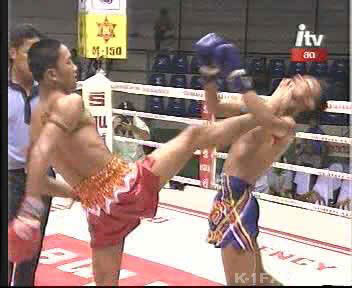






 China plans to give a large-scale facelift to the Shaolin Temple area in central Henan Province, where the renowned Shaolin kung fu (martial art) originated.
China plans to give a large-scale facelift to the Shaolin Temple area in central Henan Province, where the renowned Shaolin kung fu (martial art) originated.


